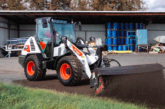
The recovery of a sophisticated hydraulic breaker that was stolen from a site in Southampton last summer marked something of a turning point in excavator attachment technology, as Keith Moody, product development manager from earthmoving attachments specialist, Miller, explains.
In August 2015, specialist retail and forecourt construction contractor Williams Southern had a new hydraulic breaker stolen, and contacted the attachment’s owner, Hewden, to inform it of the theft.
In the past, such a situation might have involved Hewden writing Williams Southern a hefty bill, leading to the contractor having to make an insurance claim and suffer disruption to the work they were carrying out – but no such expense or loss of productivity was required this time.
Hewden knew that the breaker, manufactured by Miller, was fitted with a global positioning satellite tracker, and contacted Automatrics – the tracking company responsible for ascertaining the location of stolen equipment – straight away.
The efficiency and simplicity of the breaker’s recovery was nothing short of remarkable. The initial report was made to Hewden at 10.46am on 26th August, and by 11.13am Automatrics had been alerted. The breaker’s GPS signal was quickly traced, and a detection team began to hone in on the location of the item.
 By 5.19pm that evening – less than seven hours after the item was reported missing – the police were forcing open the door of a white transit van that contained the stolen attachment.
By 5.19pm that evening – less than seven hours after the item was reported missing – the police were forcing open the door of a white transit van that contained the stolen attachment.
Bucking the trend
Despite the overall decline in plant theft in recent years, since the Home Office set up the Plant Theft Action Group (PTAG) in 2000, the UK construction industry continues to lose an estimated £800 million per year through the various costs associated with theft, including replacement purchase costs, replacement hire, loss of business and increased insurance premiums.
Data suggests that the theft of smaller items, such as excavator attachments, that can be easily concealed and transported, are a particular target for thieves and the loss of items such as breakers is actually on the rise.
The Plant and Agricultural National Intelligence Unit reported that attachment theft was up by 80 per cent in the first quarter of 2015, compared to the previous year and Hewden estimates that attachment theft alone is hitting the industry to the tune of £1 million per year.
Breaker innovation
Installing a GPS tracker into a breaker is an innovation that harnesses modern satellite technology, and the power of tracking logistics, in order to recover stolen items or deter criminals, thereby reducing downtime and associated costs.
Along with this security measure, Miller is pioneering a number of key features in its new high impact hydraulic breaker that could have a similarly transformative effect and provide considerable savings for the end user, as well as rental companies.
The new breaker’s efficient, silenced design, with fewer component parts making for lower running costs, instantly gives it an edge over traditional breakers and will appeal to contractors working on tight budgets and built up locations.
The issue of damage to attachments, such as breakers, is often down to poor maintenance. Miller’s auto-lubrication system, which automatically greases tool components during use to maintain the smooth operation of the attachment, without the operator having to stop working, lowers maintenance and repair costs, and also extends the lifetime of the tool, the tool pin, and bushes.
 A better, safer future
A better, safer future
While efficiency and security are key considerations, safety is the paramount concern at any site, and the improvements being made to excavator attachments reflect this.
Constructors working with mixed fleets of machines face the labour-intensive, often dangerous process of changing breakers on a regular basis. Miller’s hydraulic breaker features a uniquely engineered hanger solution, so the attachment will fit multi OEM machines and sizes.
The universal head bracket can be switched easily between machines, and features interchangeable pins to make the process smoother still. Depot pre-delivery bracket change times have reduced from 30 minutes to less than two minutes, demonstrating a significant leap forward in efficiency.
Further issues many operators experience with breakers include blank firing and through bolt fracture. An auto-stop system on Miller’s breakers eliminates the internal shock caused by blank firing, which stops breaker operation as soon as material has been broken through to prevent breakage to components.
This prolongs the durability and lifetime of the breaker, as well as making a significant improvement to the operator experience.
The breaker’s large diameter through bolt imparts a higher torque on the nuts to prevent them from loosening, and protects internal components from damage by minimising through bolt fracture.
Evidence from companies like Hewden, which has embraced the use of improved breaker technology, suggests that the days of expensive attachments going missing, malfunctioning, and creating an unnecessary time stuck on sites are fast becoming a thing of the past.
Breaker systems like Miller’s are raising the bar on all fronts to give contractors the most economic, safe, secure attachments ever produced.
The manufacturer’s hydraulic breaker is 15 per cent more efficient than other systems, increasing productivity by keeping oil temperatures low and enabling the breaker to work for longer periods – with no loss of performance.








